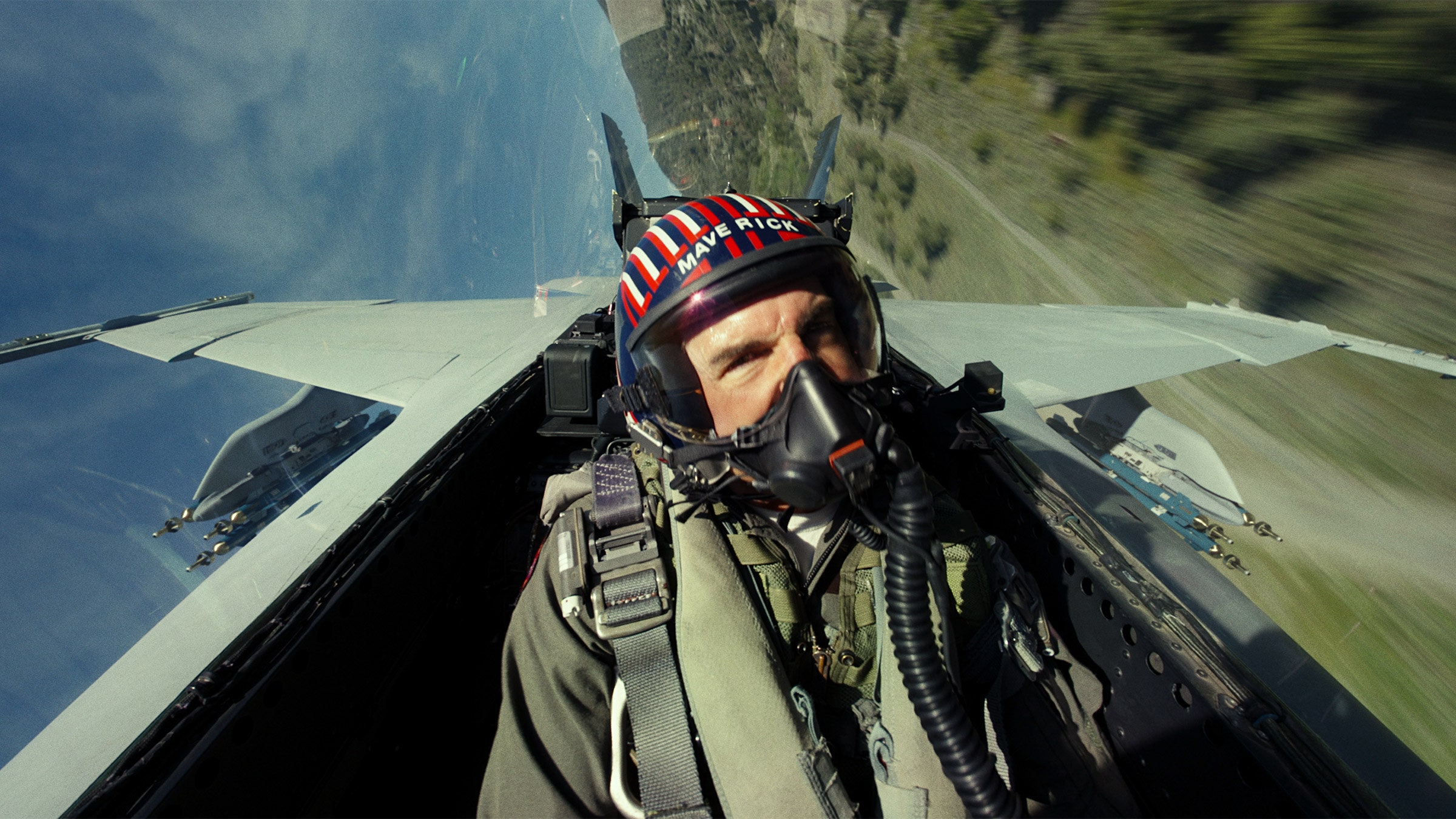
Top Gun isn’t a movie. It’s music. It’s the kind of story sung by ancient Greek poets who beseech the Muses for inspiration. With the addition of a sequel, Top Gun: Maverick, to the 1986 original, Top Gun is now a film cycle about a a group of men – warriors, the troubled, crafty kind – and a few women – the loyal, tempestuous type – who are interesting characters in their own right but who also stand in for the values of their society. So while going to see a Top Gun movie at the theater feels at first like going to see any other action blockbuster, it ends up being more like meandering through a temple and gazing upon frescos plastered on the columns and walls. Top Gun is iconographic. Future historians will understand this better than we do.
I am using “Top Gun” here to refer to both films in the cycle with purpose. They are so alike in their shape and style, we really should consider them as one film. They become a liturgy performed for the audience by a high priest. Liturgies include all the same elements each time but are performed in slightly different ways. The same is true of Top Gun: Maverick.
Top Guns are war films for a society that no longer storms beaches, be they the beaches of Normandy or the beaches of Troy. Now we no longer even fly planes. Drones hover over Top Gun: Maverick, and the film really doesn’t give a logical reason why they can’t perform the task at hand in the story. But stories like this aren’t about what is logical. The original film was made during a time when America had no rival in the skies. These stories are about what is necessary for the self-realization of the characters, our exemplars showing us who we are supposed to be if ever the circumstances call for it.
It is interesting that we feel a need to nurture the warrior spirit even now. Homer’s Odyssey follows his Iliad. The first tale is one of heroes, high ideals, and great battles. The sequel tells a different kind of story, one where that kind of masculinity needs to settle down. It is not a time of war. It is a tale for a time of peace. All the heroes save one, a clever but normal man named Odysseus, are dead.
Pete “Maverick” Mitchell finds himself in a similar situation. He’s the last of a dying breed. He’s tasked with training some youngsters for a mission that requires pilots. There is a lot of sadness in this story, real grief. There are things left unsaid, because to keep them quiet is a way to honor the dead. Maverick seems to want to cross the barrier into eternity, but he keeps getting pulled back to earth. There are no gods in this story, but if there were, they would apparently be set on making Maverick go through one last trial to resolve one last restless matter in his soul.
This all comes to a head in an arial action sequence unmatched in thrills since the one that took place a long time ago in a galaxy far, far away. We should know by now that Tom Cruise is going to give us the most visceral action scenes we might ever see at the movies. That we expect it, and he continues to deliver beyond our expectations is remarkable. The original film ended with a top-notch action sequence too. When it’s all over, Maverick is in a better place. Are we?
Why do we tell the same stories over and over again until they become synonymous with our culture? Why do we have liturgies? Homerian epics and religious rites accomplish the same thing – they remind us who we think we are meant to be.
Top Gun tells us to be brave. It tells us that loyalty to our country, our compatriots, and to our own sense of right and wrong is important even if we aren’t in a time fo war. These things are true. They just shouldn’t be taken to jingoistic extremes. And as exciting as Top Gun: Maverick is, I do wonder what happens to us as we metabolize it. We don’t have fighter jets at our disposal. We don’t need them. Where do we funnel our aggression? What kind of man is Odysseus when he finally arrives in Ithaca? What happens next?
Only the intervention of a god can stop Odysseus from returning to war.
Top Gun isn’t a movie. It’s music. It’s the kind of story sung by ancient Greek poets who beseech the Muses for inspiration. With the addition of a sequel, Top Gun: Maverick, to the 1986 original, Top Gun is now a film cycle about a a group of men – warriors, the troubled, crafty kind – and a few women – the loyal, tempestuous type – who are interesting characters in their own right but who also stand in for the values of their society. So while going to see a Top Gun movie at the theater feels at first like going to see any other action blockbuster, it ends up being more like meandering through a temple and gazing upon frescos plastered on the columns and walls. Top Gun is iconographic. Future historians will understand this better than we do.
I am using “Top Gun” here to refer to both films in the cycle with purpose. They are so alike in their shape and style, we really should consider them as one film. They become a liturgy performed for the audience by a high priest. Liturgies include all the same elements each time but are performed in slightly different ways. The same is true of Top Gun: Maverick.
Top Guns are war films for a society that no longer storms beaches, be they the beaches of Normandy or the beaches of Troy. Now we no longer even fly planes. Drones hover over Top Gun: Maverick, and the film really doesn’t give a logical reason why they can’t perform the task at hand in the story. But stories like this aren’t about what is logical. The original film was made during a time when America had no rival in the skies. These stories are about what is necessary for the self-realization of the characters, our exemplars showing us who we are supposed to be if ever the circumstances call for it.
It is interesting that we feel a need to nurture the warrior spirit even now. Homer’s Odyssey follows his Iliad. The first tale is one of heroes, high ideals, and great battles. The sequel tells a different kind of story, one where that kind of masculinity needs to settle down. It is not a time of war. It is a tale for a time of peace. All the heroes save one, a clever but normal man named Odysseus, are dead.
Pete “Maverick” Mitchell finds himself in a similar situation. He’s the last of a dying breed. He’s tasked with training some youngsters for a mission that requires pilots. There is a lot of sadness in this story, real grief. There are things left unsaid, because to keep them quiet is a way to honor the dead. Maverick seems to want to cross the barrier into eternity, but he keeps getting pulled back to earth. There are no gods in this story, but if there were, they would apparently be set on making Maverick go through one last trial to resolve one last restless matter in his soul.
This all comes to a head in an arial action sequence unmatched in thrills since the one that took place a long time ago in a galaxy far, far away. We should know by now that Tom Cruise is going to give us the most visceral action scenes we might ever see at the movies. That we expect it, and he continues to deliver beyond our expectations is remarkable. The original film ended with a top-notch action sequence too. When it’s all over, Maverick is in a better place. Are we?
Why do we tell the same stories over and over again until they become synonymous with our culture? Why do we have liturgies? Homerian epics and religious rites accomplish the same thing – they remind us who we think we are meant to be.
Top Gun tells us to be brave. It tells us that loyalty to our country, our compatriots, and to our own sense of right and wrong is important even if we aren’t in a time fo war. These things are true. They just shouldn’t be taken to jingoistic extremes. And as exciting as Top Gun: Maverick is, I do wonder what happens to us as we metabolize it. We don’t have fighter jets at our disposal. We don’t need them. Where do we funnel our aggression? What kind of man is Odysseus when he finally arrives in Ithaca? What happens next?
Only the intervention of a god can stop Odysseus from returning to war.

Elijah Davidson is Co-Director of Brehm Film and Senior Film Critic. Subscribe to his weekly email series that guides you through film history, Come & See, and find more of his work at elijahdavidson.com.
The original cartoon, Chip ’n Dale Rescue Rangers, was itself a reboot/reimagining of a couple of classic Disney characters. Why not do it again?